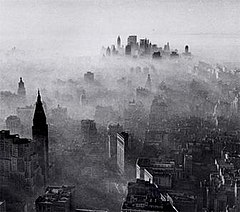1966 New York City smog

A view of the skyline looking south from the Empire State Building at 8:30 a.m. November 24, 1966. The photo was taken by Neal Boenzi and published on the front page of the November 25, 1966 edition of the The New York Times. Roy Popkin of the EPA said the "surrealistic" image made Lower Manhattan look like a "Cloud City".
|
|
| Date | November 23–26, 1966 |
|---|---|
| Location | Acute smog in New York City; lesser smog throughout the New York metropolitan area |
| Coordinates | 40°42′46″N 74°00′21″W / 40.7127°N 74.0059°WCoordinates: 40°42′46″N 74°00′21″W / 40.7127°N 74.0059°W |
| Cause | Heat inversion over East Coast |
|
There are several estimates for the number of casualties caused by the smog:
|
|
There are several estimates for the number of casualties caused by the smog:
The 1966 New York City smog was a historic air-pollution event in New York City that occurred from November 23–26, that year's Thanksgiving weekend. It was the third major smog event in New York City, following smogs of similar scale in 1953 and 1963. On November 23, a large mass of stagnant air over the East Coast trapped pollutants in the city's air. For three full days, New York City experienced severe smog with high levels of carbon monoxide, sulfur dioxide, smoke, and haze. Lesser air pollution pervaded the New York metropolitan area throughout other parts of New York, New Jersey, and Connecticut. The arrival of a cold front in the early morning hours of November 26 finally dissipated the smog.
On November 25, regional leaders initiated a "first-stage alert" in the city, state, and neighboring states. During the alert, leaders of local and state governments asked residents and industry to take voluntary steps to minimize emissions. People with respiratory or heart conditions were advised to stay indoors by health officials. The city's garbage incinerators were shut off, requiring massive hauling of garbage to landfills. A cold front dispersed the smog on November 26 and the alert ended. A medical research group conducted a study estimating that 10 percent of the city's population suffered some negative health effects from the smog, such as stinging eyes, coughing, and respiratory distress. City health officials initially maintained that the smog had not caused any excess deaths. However, a statistical analysis indicated that 168 people likely died because of the smog, and another study found 366 people likely had their lives shortened.
The smog served as a catalyst for greater national awareness of air pollution as a serious health problem and political issue. New York City updated its local laws on air pollution control, and a similar weather event passed in 1969 without major smog. Prompted by the smog, President Lyndon B. Johnson and members of Congress worked to pass federal legislation regulating air pollution in the United States, culminating in the 1967 Air Quality Act and the 1970 Clean Air Act. Today, the smog has served as a milestone used for comparison with other recent pollution events, including the health effects of pollution from the September 11 attacks and pollution in China.
...
Wikipedia
